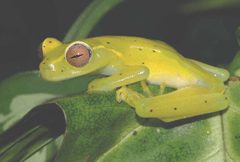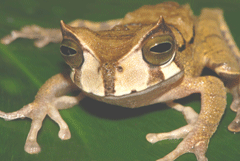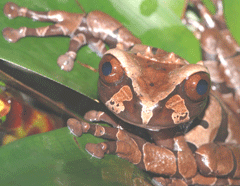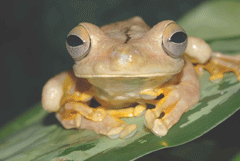Leaping Towards a Solution
Air Date: Week of February 29, 2008

Hyloscirtus colymba, currently housed at the El Valle Conservation Center in Panama. (Photo: Bill Konstant, Houston Zoo)
What better way to celebrate leap year than by highlighting the plight of our amphibian friends? A third of the world’s frog populations face extinction. Host Steve Curwood speaks with Shelly Grow, of the Association of Zoos and Aquariums, about their efforts to highlight the problem with a series of exhibits and events.
Transcript
CURWOOD: 2008 isn’t just any year. It’s a leap year: the quadrennial event when the calendar plays catch-up with things celestial, and February has 29 days. To mark the leap, the Association of Zoos and Aquariums is turning to the quintessential leaper: the frog.
At some 90 zoos and aquaria across the country you’ll be able to compete in croaking contests and amphibian scavenger hunts, and of course, leap frog. But it won’t all be fun and games, says Shelly Grow of the Association. She says by making this leap year the Year of the Frog, the organization hopes to highlight the fight for survival for amphibians around the world. A third of the six thousand or so amphibian species face extinction from an unusual pathogen. Shelly Grow is on the line – so Shelly, tell me about this disease.

Gastrotheca cornuta, currently housed at the El Valle Conservation Center in Panama. (Photo: Bill Konstant, Houston Zoo)
CURWOOD: Where did this fungus come from and why is it so devastating?
GROW: The current hypothesis is that it has come from Africa and probably was shipped in the African clod frog, which in the ’thirties and ’forties was shipped around the world for use in pregnancy tests.
CURWOOD: Frogs in a pregnancy test?
GROW: Yes, this was…Actually it was a very popular pregnancy test and the idea was that if you injected some of a woman’s urine into an amphibian, if the amphibian were to lay eggs, then that would be a sign that the woman was pregnant. And what was great about this is that results – the amphibian would lay eggs within eight to 12 hours, so these were really quick results for a pregnancy test. Much quicker than previous tests had been. And this remained very common up until the ’sixties when other methods of detecting the hormone in women that were pregnant were discovered.
CURWOOD: Now, fungus is one really stressor on frogs, what are the other major factors that are threatening amphibians at this point?

Hyloscirtus colymba, currently housed at the El Valle Conservation Center in Panama. (Photo: Bill Konstant, Houston Zoo)
CURWOOD: So let me understand this, the zoos and aquaria are calling for the removal of frogs from their habitat in the face of this disease?

Shelly Grow, Conservation Biologist, Association of Zoos and Aquariums. (Photo: R. Andrew Odum Toledo Zoo)
CURWOOD: So, I have a pond in my backyard. Should I get out there with my net and capture some of these leapers and bring them in for the next couple years.
GROW: Absolutely not. The idea is that still the leading threat for amphibians is habitat loss and destruction, so if you have a pond in your backyard, the best thing is to make sure that it is healthy habitat for your local amphibians. So that there’s not lawn chemicals running off into it. Or that you’re not draining it to put in a basketball court or things like that. But the idea is that we really want to have habitat available for these amphibians.

Anotheca spinosa, currently housed at the El Valle Conservation Center in Panama. (Photo: Bill Konstant, Houston Zoo)
GROW: We’ve used them for anti-tumor properties, or we found anti-tumor properties, anti-inflamatories. There’s been some research saying there may be some compounds in some amphibians that may help against HIV, so that’s again, going back to the medical purposes. But then we also use them for – we benefit greatly from the insect control that they play for us. People are concerned about what would happen if there’s a huge die-off in amphibians, what would happen to insect-born diseases like yellow fever, or malaria? What would happen in agricultural fields if the amphibians are gone and not helping with pest control? And then there are the roles that they play in the wider ecosystem, a food web, what would happen to birds and snakes and spiders if their food source were to disappear in great numbers.

Hypsiboas rosenbergi, currently housed at the El Valle Conservation Center in Panama. (Photo: Bill Konstant, Houston Zoo)
GROW: You know, I actually don’t have a favorite amphibian. I can get so excited by just some of the names of some of these amphibians, like the hell bender, and that is also known as the snot otter, and all sorts of great salamanders, but then there’s some really just gorgeous, downright beautiful frogs out there as well, so… I don’t know. And then I’m pretty grateful for those that are eating the mosquitoes in my own backyard, so I don’t think I have a favorite.
CURWOOD: I guess I have to confess that my favorite probably is Kermit, even though he’s not a real frog, but a puppet.
GROW: He is awfully lovable and he has been a great celebrity on behalf of all amphibians out there.
CURWOOD: Shelly Grow is a conservation biologist with the Association of Zoos and Aquariums. Thanks so much, Shelly.
GROW: Thank you so much for having me.
CURWOOD: To learn more about The AZA’s Year of the Frog activities, leap on over to our web site: L-O-E dot O-R-G.
[MUSIC: “It’s Not Easy Being Green” (You Tube video from Sesame Street)]
Links
Living on Earth wants to hear from you!
Living on Earth
62 Calef Highway, Suite 212
Lee, NH 03861
Telephone: 617-287-4121
E-mail: comments@loe.org
Newsletter [Click here]
Donate to Living on Earth!
Living on Earth is an independent media program and relies entirely on contributions from listeners and institutions supporting public service. Please donate now to preserve an independent environmental voice.
NewsletterLiving on Earth offers a weekly delivery of the show's rundown to your mailbox. Sign up for our newsletter today!
 Sailors For The Sea: Be the change you want to sea.
Sailors For The Sea: Be the change you want to sea.
 The Grantham Foundation for the Protection of the Environment: Committed to protecting and improving the health of the global environment.
The Grantham Foundation for the Protection of the Environment: Committed to protecting and improving the health of the global environment.
 Contribute to Living on Earth and receive, as our gift to you, an archival print of one of Mark Seth Lender's extraordinary wildlife photographs. Follow the link to see Mark's current collection of photographs.
Contribute to Living on Earth and receive, as our gift to you, an archival print of one of Mark Seth Lender's extraordinary wildlife photographs. Follow the link to see Mark's current collection of photographs.
 Buy a signed copy of Mark Seth Lender's book Smeagull the Seagull & support Living on Earth
Buy a signed copy of Mark Seth Lender's book Smeagull the Seagull & support Living on Earth

